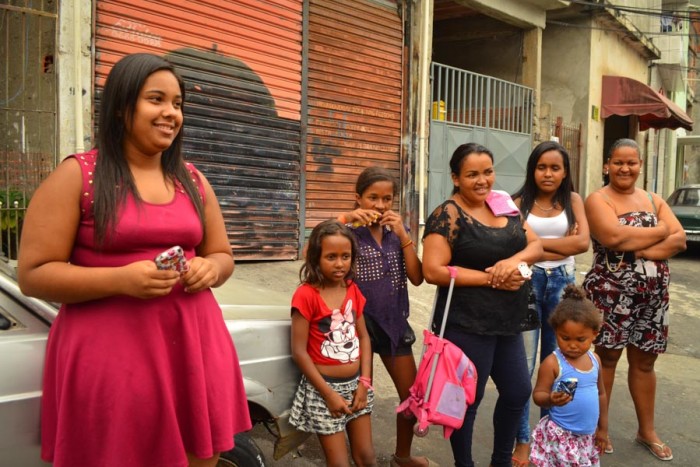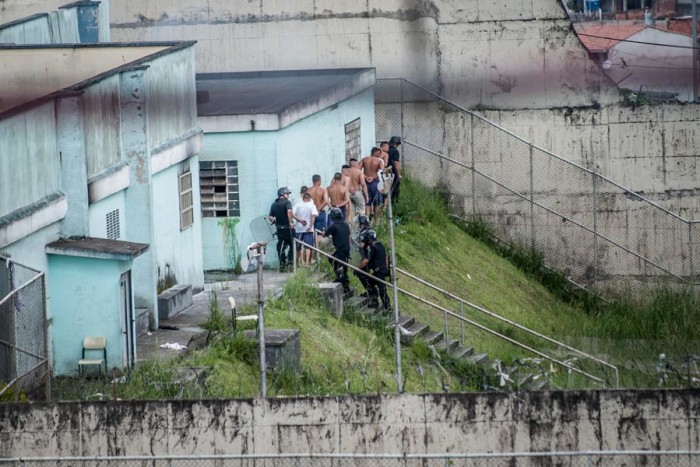(Video by Katherine Jinyi Li and UNAS)
I’m a Pacific Northwest Native, but these days I live and work as a youth journalism teacher in São Paulo’s Heliópolis neighborhood. It’s the second largest favela in Latin America, where over 200,000 residents live inside of an area about one third of a square mile.
When I asked my students recently what issue most defines their lives today, they immediately jumped into a heated debate about a proposed youth crime reform bill being considered by the Brazilian government. The proposal would reduce the age at which you could be tried as an adult from 18 to 16 years old.
“Kids are committing crimes at younger and younger ages these days,” says Leonardo, an 18-year-old Heliópolis resident who supports the reform. “Here in the favela, there’s a right path and a wrong path to go down. At any minute I could be shot and killed by some kid who went down the wrong one.”
In most ways, Heliópolis couldn’t be more different than Seattle. But ever since the King County Council’s unanimous decision to build the new Children and Family Justice Center — or what opponents are calling the “new youth jail” — Seattle has been embroiled in a surprisingly familiar debate about youth detention.
With two of the world’s largest prison populations, Brazil and the U.S. face similar issues of youth crime, a dismal school-to-prison pipeline and disproportionate incarceration rates for small drug crimes.
Giovanni, a 17-year-old student in my video-journalism class, agrees that criminality is common amongst youth in working-class communities, but argues that young people are more often the victims than the perpetrators of crime.
“We’re victims of societal manipulation,” says Giovanni. “The media is constantly showing images of favela youth as criminals on the margins of society, which is what the people in power want everyone to see us as.”
Brazil’s last decades of consumerist boom and subsequent economic slump has created a millennial generation desperate to get their hands on the latest smartphone or pair of Nikes, but poorly equipped with limited socioeconomic opportunities.
“It all comes down to consumerism,” Giovanni explains. “Young people see nice things on TV and think that these things are necessary to having a good life. They know they don’t have the money for it, so they simply hit the streets to steal it.”

Despite rising youth crime rates, less than 1% of serious crimes like murder, robbery, theft, and rape in Brazil are actually committed by minors. As victims, however, young Brazilians are often the most vulnerable. Brazil’s 2014 Youth Violence Map reported that 30,000 of the 56,000 people murdered in 2012 where between the ages of 15 and 29. In the last year, 151,000 children under 17 reported to the national human rights hotline “Disque 100” as victims of mistreatment and aggression.
Milena, a 16-year-old, Heliópolis resident, thinks reducing the age for adult criminal responsibility will only aggravate the issue of youth crime.
“Alright if people want a 16-year-old to serve the sentence of an 18-year-old,” she says. “But simply investing in prisons will only exclude that teenager even further from society.”
Reginaldo Gonçalves, a youth coordinator for over 20 years with the Heliópolis community organization “UNAS” argues that reducing the adult trial age won’t scare youth away from crime, but rather drive them to it.
“We work with favela youth every day, we know how they think and act,” says Gonçalves. “The more we invest in prisons, the less we have to offer young people in our community an alternative to crime —educational, professional, or cultural activities.”
“This reform unfairly targets working-class youth,” says Milena. “A rich kid can steal and murder but pay bail and be out of jail easy, while a kid from the favela will be stuck in prison.”
Working-class communities like Heliópolis suffer frequent school closures and a scarcity of public funding for youth programs, leaving young people to the streets in their free time. Heliópolis is infamous for its giant baile funk — all-night street raves where sex, drugs, cars, sound systems and latest fashions are on vibrant display. The high schoolers in my video-journalism workshop lament the inevitability of getting caught up in the lawless street fluxo — local slang for these kinds of street parties in the slums.
“Dancing, prostitution, drugs, alcohol — you want to go out on the weekend with your friends, you hit up the fluxo, there’s nothing else around here to do,” says Milena.
But contrary to media stereotypes about Brazil’s favelas, Heliópolis is actually one of the safest places to live in São Paulo. Giovanni says it’s a question of respect for the community and fear of retribution for crimes committed inside the neighborhood.
“If a young person from around here commits a crime, he leaves Heliópolis to do it somewhere else,” he said “Never mind the outside authorities, he never knows what kind of punishment he might face from within the community itself.”

The bill to reduce the age of adult criminal responsibility from 18 to 16 years old, or “redução da maioridade penal,” made headlines this year after passing in the Brazilian Chamber of Deputees (similar to the U.S. House of Representatives) by a resounding majority. The bill has since been frozen in the Senate as the government reels from a recent corruption scandal and economic turmoil.
While this kind of bill has been on the table for over twenty years, first proposed as a constitutional amendment to Brazil’s 1990 Statute of Children’s Rights (ECA), never before has the reform had such strong conservative support.
The bill’s sponsor, Laerte Bessa, has pledged to crack down on youth crime even to the extreme of forced abortions.
“One day, we will be able to determine whether a child in the womb has criminal tendencies and if it does the mother won’t be allowed to give birth,” said Bessa in an interview with the Guardian.
The standing penal reform makes no mention of the existing juvenile corrections system, called Fundação Casa (formerly FEBEM), which holds 10,000 minors in the state of São Paulo alone. For every 100 state prisoners, 13 are minors. Just like in the U.S., most young detainees are brought in for minor drug offenses. The Fundação Casa’s are infamous for inhumane disciplinary treatment, overcrowded quarters and regular prison riots.
My Brazilian students are shocked when I tell them that the U.S. doesn’t even have a federal age limit to sending minors to adult prisons, and that some states have given adult sentences to children as young as 10 years old.
Yes, even their “first-world” northern neighbors haven’t realized that the solution to youth crime isn’t jail time, but socioeconomic opportunities that are alternatives to crime. In Brazil and U.S., we need more cultural programming, vocational courses and employment programs — not more prison cells.
The underlying problem with youth incarceration policies, whether in Seattle or São Paulo, is that young people themselves are rarely invited to the policy-making table, nor do they receive enough political education about youth rights and how to claim them. Young people turn to crime because we have failed to bring them into any social fabric.
If we listen to our young people, they’ll tell us to stop building prisons and instead invest in spaces where conscious, engaged citizens can grow.


The common thread is single parent families and overpopulation. These are cultures and sub-cultures were single parents are accepted and becomes the norm. And these groups have kids they cannot afford and so they feel entitled to forcing others to provide for them or they just let these kids they created suffer.
I wonder who is the worse person: the person who saves money, is careful about planning, and only has kids they can afford, or the people who just have kids, don’t worry about marriage, don’t worry about planning, and keep on having kids regardless of the suffering they are creating?
Its pretty clear the careless breeder is the one causing suffering. And yet you see leftist acting like its the well off family “the privileged” who are bad…when their crime is really one of caring, planning, and living responsibly.
Imagine much less poverty there would be if everyone just had only the kids they could afford to raise. And wouldn’t that also be the recipe for protecting the environment?
You can see that South Koreans, Japanese, Sweds, Norwegians, Canadians and others who have few kids are also wealthier. They come to the US and do very well. They plan and live within their means and they believe in traditional family.
These are the traits that divide. Its not race. Its culture. If you want to best predict who while have successful families look at who plans carefully, has stable marriages, and who feels they should only have kids they can directly support. Those are the people who will produce just societies.